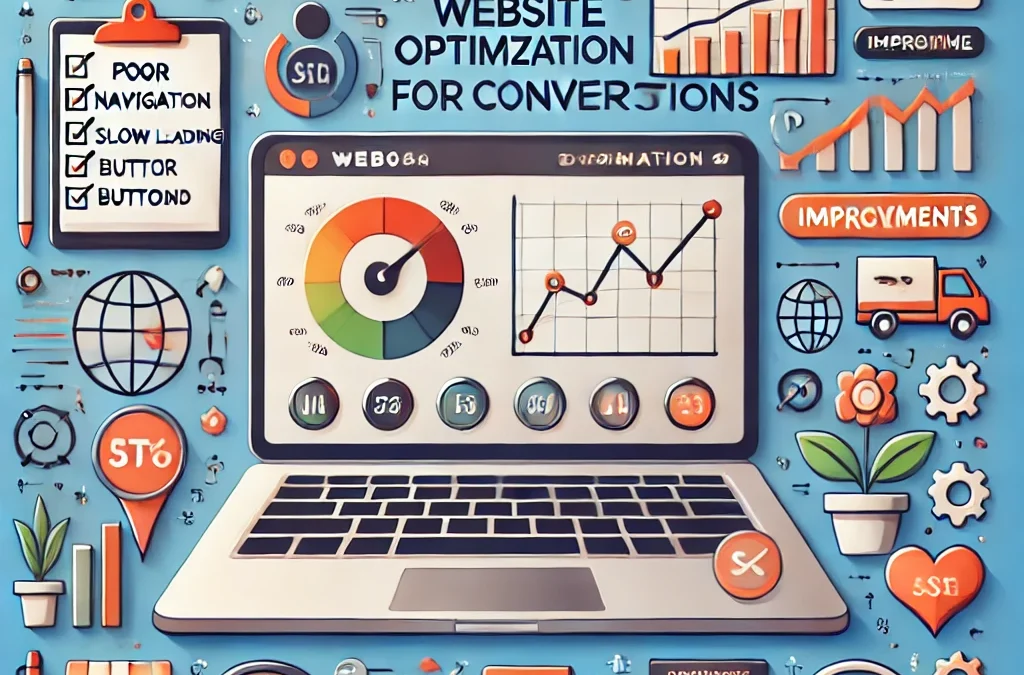Website Mistakes That Are Killing Your Conversions—And How to Fix Them
For small businesses, a well-designed website is one of the most valuable tools to drive conversions. However, even minor mistakes in layout, content, or functionality can turn potential customers away, leading to lost sales and wasted marketing efforts. This article explores the most common website mistakes that kill conversions and provides actionable steps to help you fix them.
Why Website Conversions Matter
Conversions are the desired actions you want visitors to take on your website, whether it’s making a purchase, signing up for a newsletter, or filling out a contact form. A high conversion rate means your site effectively turns visitors into leads or customers. Addressing the following common website issues can help you boost conversions and get the most out of your online presence.
Mistake 1: Poor Website Navigation
Problem
If visitors can’t quickly find what they’re looking for, they’re likely to leave. Complicated or cluttered navigation can create frustration and reduce the chances of conversion.
Solution
- Simplify Navigation: Keep your menu items limited to essential pages, such as Home, About, Services, and Contact. Avoid excessive dropdown menus that make it harder for users to find key information.
- Include a Search Bar: A search function allows users to quickly locate specific information, especially on content-rich sites.
- Use Clear Labels: Name menu items clearly and avoid industry jargon. Use standard labels that are easy to understand, like “Blog” or “Contact.”
Action Steps:
- Review your current navigation structure and remove any unnecessary items.
- Test the layout by asking people unfamiliar with your business to find specific information and see how quickly they can locate it.
- Add a search bar and use tools like Google Analytics to track common search terms.
Mistake 2: Slow Page Load Times
Problem
Visitors expect a website to load quickly—within 2-3 seconds. A slow website can increase bounce rates and lower conversion rates as potential customers leave before the page even loads.
Solution
- Optimize Images: Compress and resize images to reduce loading time. Tools like TinyPNG or JPEG-Optimizer are great for this.
- Minimize HTTP Requests: Limit the number of elements on each page, such as scripts, images, and CSS files.
- Use Browser Caching: Caching stores parts of your website on a visitor’s device, so it loads faster when they return.
Action Steps:
- Use Google PageSpeed Insights or GTmetrix to analyze your site’s loading speed and identify areas for improvement.
- Compress images and remove any that aren’t necessary for the page content.
- Consider using a content delivery network (CDN) like Cloudflare to improve load speeds, especially if you have a global audience.
Mistake 3: Unclear Calls-to-Action (CTAs)
Problem
If your calls-to-action (CTAs) aren’t clear or compelling, visitors won’t take the next step. CTAs that are too subtle or vague can lead to missed conversions.
Solution
- Make CTAs Stand Out: Use contrasting colors and larger fonts to make your CTAs visually appealing.
- Use Action-Oriented Language: Write CTAs that clearly state the desired action, like “Get Started,” “Claim Your Free Trial,” or “Download the Guide.”
- Place CTAs Strategically: Ensure CTAs are visible above the fold, at the end of blog posts, and on product pages to maximize visibility.
Action Steps:
- Identify key conversion points on your website and add or refine CTAs on these pages.
- Use A/B testing to test different CTA text, colors, and placements.
- Track click-through rates on CTAs to determine their effectiveness and make necessary adjustments.
Mistake 4: Lack of Mobile Optimization
Problem
With over half of all internet traffic coming from mobile devices, a website that isn’t mobile-friendly can cost you valuable leads and conversions.
Solution
- Use Responsive Design: Ensure your website’s layout adapts to different screen sizes so it looks and functions well on smartphones and tablets.
- Optimize Button Sizes: Make buttons and links large enough to be easily tapped on a mobile screen.
- Streamline Content: Prioritize essential information for mobile users to reduce scrolling and make navigation easier.
Action Steps:
- Test your website’s mobile responsiveness using Google’s Mobile-Friendly Test.
- Adjust font sizes, button sizes, and spacing to improve the mobile user experience.
- Regularly check your website on different mobile devices to ensure everything functions smoothly.
Mistake 5: Overwhelming or Distracting Design
Problem
An overly complex or visually busy website can distract visitors from taking action. Too many colors, fonts, or animations can overwhelm users and detract from your main message.
Solution
- Simplify the Design: Choose a clean, minimalistic design that focuses on user-friendliness. Limit your use of colors, fonts, and animations.
- Highlight Key Information: Make sure your most important information, like your CTA or product details, is easy to spot and not hidden by distracting elements.
- Use White Space: White space helps guide users’ attention and makes content more readable.
Action Steps:
- Review your site design and remove any unnecessary elements, such as animations or decorative images.
- Use white space to create visual breathing room around important information.
- Limit your color scheme to 2-3 main colors that align with your brand.
Mistake 6: Not Showcasing Social Proof
Problem
Social proof, like reviews, testimonials, or case studies, builds trust with potential customers. Without it, visitors may feel uncertain about your business and hesitate to convert.
Solution
- Add Customer Testimonials: Include positive feedback from satisfied customers on your homepage or product pages.
- Showcase Case Studies or Success Stories: Highlight real-life examples of how your products or services helped other customers.
- Display Trust Badges: Certifications, secure payment symbols, or industry awards can also build credibility.
Action Steps:
- Collect testimonials from happy customers and place them strategically on your site.
- Create a dedicated page for case studies or success stories.
- If applicable, display security badges or certifications to build trust.
Mistake 7: Confusing or Cluttered Forms
Problem
Forms that are too long, unclear, or confusing can discourage visitors from completing them, resulting in lost leads.
Solution
- Limit Form Fields: Only ask for essential information to keep forms short and simple. For example, just ask for name and email if it’s a newsletter sign-up form.
- Use Clear Labels: Ensure each form field is clearly labeled so users know exactly what information is required.
- Add Progress Indicators: For multi-step forms, let users know how many steps are left to encourage them to complete it.
Action Steps:
- Review each form on your site and remove any unnecessary fields.
- Test forms to ensure each field is labeled and easy to understand.
- If using a multi-step form, add a progress bar or indicator to guide users.
Mistake 8: Ignoring SEO Best Practices
Problem
If your website isn’t optimized for search engines, potential customers may never find it, reducing your conversion opportunities.
Solution
- Optimize Meta Titles and Descriptions: Include relevant keywords in your meta titles and descriptions to improve search engine visibility.
- Use Headers and Subheaders: Organize your content with H1, H2, and H3 tags, making it easier for users and search engines to understand.
- Add Alt Text to Images: Describe your images with alt text to improve SEO and make your site more accessible.
Action Steps:
- Review your pages for SEO optimization, including title tags, meta descriptions, and headers.
- Add alt text to all images to improve accessibility and search visibility.
- Use a tool like Yoast SEO if you’re on WordPress to guide your optimization efforts.
Mistake 9: Failing to Use Analytics to Track Performance
Problem
If you aren’t tracking your website’s performance, you won’t know which areas are underperforming or which changes are improving conversions.
Solution
- Set Up Google Analytics: Use Google Analytics to track key metrics like bounce rate, average session duration, and conversions.
- Use Heatmaps: Heatmaps like Hotjar or Crazy Egg can show you where users click and how far they scroll, giving insights into user behavior.
- Set Up Conversion Goals: Track specific actions on your website, such as form submissions or completed purchases.
Action Steps:
- Install Google Analytics and review key metrics regularly.
- Use heatmap tools to identify areas where users engage most and least.
- Set up conversion goals to track the effectiveness of CTAs, forms, and other key elements.
Final Thoughts
Improving your website’s conversion rate requires identifying and addressing the factors that could be turning visitors away. From optimizing navigation and page load speed to refining CTAs and showcasing social proof, each improvement can increase the likelihood that visitors will take action on your site.
By taking these actionable steps, your small business can build a more user-friendly, conversion-focused website that effectively engages and retains customers.


